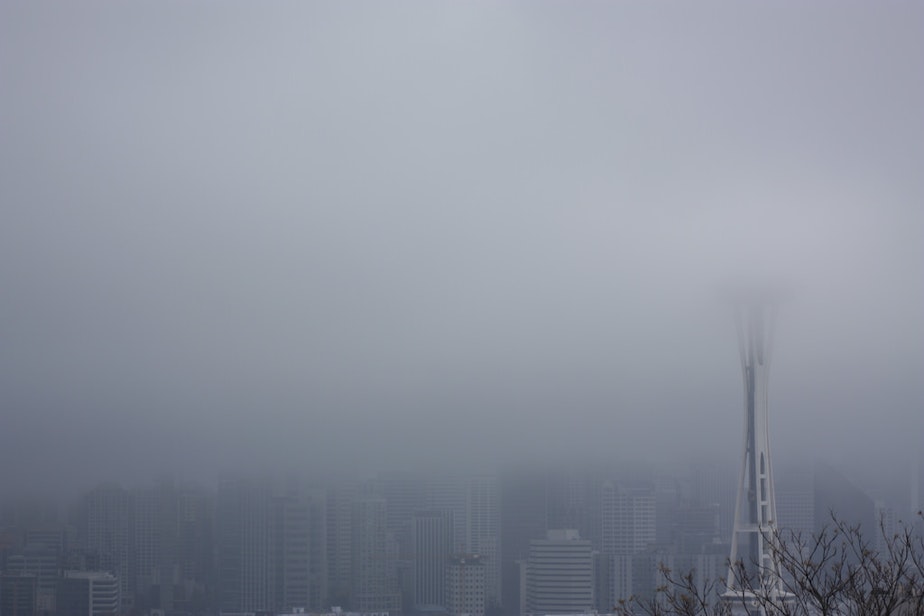Welcome to winter: You can do it!

The winter solstice was this morning at 8:28 a.m. – if you’re reading this, you’re through the darkest point of the year. But we know it may not feel like it. What to do to beat the winter blues in Seattle? Host Marcie Sillman spoke to some experts to help us answer that question.
Scott Sistek is a meteorologist at KOMO News and considers himself the spokesperson for Seattle’s rain fans. He told us what to expect this winter (if you like rain, you’re definitely in luck).
Expect lots of rain. We’re in a La Niña weather pattern this year. That means it’ll be a colder, wetter winter. But on the plus side, greater chances of lowland snow mean a higher chance the mountain will be great for skiing.
Have fun with weather terminology. If you didn’t learn what a bombogenesis was over the last few years of meteorological hype, Sistek explained that it’s basically a sneak attack – when a weak storm suddenly strengthens enormously just before it hits an area.
Our recent sunny weather was due to a ridge of high pressure. He and his colleagues are advocating to name it Ridgey McRidgeFace (because the internet). However, Ridgey seems to have left town; we may have a white Christmas after all.
Worst case: run for it. Sistek is a huge fan of the weather in the Pacific Northwest. “My dad was in the Coast Guard, and I grew up all over the Northwest,” he said. Sistek just got used to the fog. And the rain makes things sparkle. “It keeps the air clean.” If, however, you really cannot deal with the grey: “Sunshine is only a plane ride away.”
Dr. David Avery, psychiatry professor emeritus at UW School of Medicine, explained the physiology of seasonally influenced depression and shared tips on how to beat the season. And it doesn’t just involve hibernating!
Your clock is off. When there’s a lack of morning daylight in the winter, your circadian rhythms shift clockwise. It’s kind of like your body is chasing the sun. This means we’re trying to wake up when our bodies think it’s the middle of the night.
It’s not just you: Seattle is especially bad. Seasonal depressive issues tend to be worse as you get farther away from the equator: 1 percent of the population suffers from it in Florida, but it’s closer to 10 percent in Seattle. In his practice, Avery has also found that even clients moving here from New England and the Midwest are more likely to struggle here. “The cloud cover up here does make it worse,” he admitted.
Artificial light is the problem. We may be making things much worse with our phones. Our bodies adapted a specific sensitivity to blue light – the color of the sky. The blue light in screens disrupts everything by making our photoreceptors believe we’re looking at a blue sky in the middle of the night. And on the other end we find it impossible to wake up in time to get to work or school on a pitch-black morning.
…but it’s also one of the solutions. Dawn simulators and lightboxes can both help your body get the right amount of light at the times when you need it most. “Extend the photo period,” Avery advises. That means bright light exposure in the morning and the middle of the day.
Keep it regular. Staying up late on Friday and Saturday nights, then trying to get up early on Monday is the equivalent of flying to Honolulu on Friday night and coming back to Washington Sunday. Avery calls it social jetlag. So unless you have the great fortune of actually flying to Hawaii on the Friday red-eye, try to wake up around the same time all week long. Also a good regular habit? Going outside. Even on a cloudy day, it’s still 10 times brighter outside than in.
So you wake up early on Saturday with the best, most virtuous intentions. Now, where should you go? To get us out of the house, we called Ana Sofia Knauf at the Evergrey. She shared some of her favorite spots in Seattle to stay warm and cheery.
Let the Volunteer Park Conservatory take you away. It’s warm, it’s bright, and the cactus room is like a visit to another world.
Kick back at Perehelion Brewery. In addition to beer, there are firepits to warm you up and live bluegrass to get you on your feet.
Hit the Silent Reading Party at the Hotel Sorrento. It’s an old-world spot to read a book, grab a cocktail, and enjoy a cozy evening.
The Tropical Butterfly House is calling you. Ana Sofia says this is a magical experience that’s good for kids, as well as adults who need to pretend they’re in the tropics – “or Florida, at the very least.”
Get in your lane at a community pool. If you can’t jump into Lake Washington (and really, how often can you comfortably jump into the lake to begin with?), relax into the waters of a warmed, well-lit pool.
(If you need me, I’ll be in the cactus room until May.) Ana Sofia also compiled a longer list of holiday ideas that you can read here.
We asked you how you keep your spirits up in winter months, and listener Sarah gave us the best possible note to leave you with.
“I embrace it 100 percent. Hiking through the wet green moss covered trees, walking on the bitter cold beaches smelling of salt, while the wind cuts through your jacket. Standing in a frigid ray of sunshine poking through the forest canopy. This is the Northwest, it’s cold and wonderful in the winter. Once you let it become a part of you – you crave it.”
We wish you lots of light, fun excursions, an appreciation of rain – and a jacket that keeps the wind out. Happy winter! You’ve got this.

